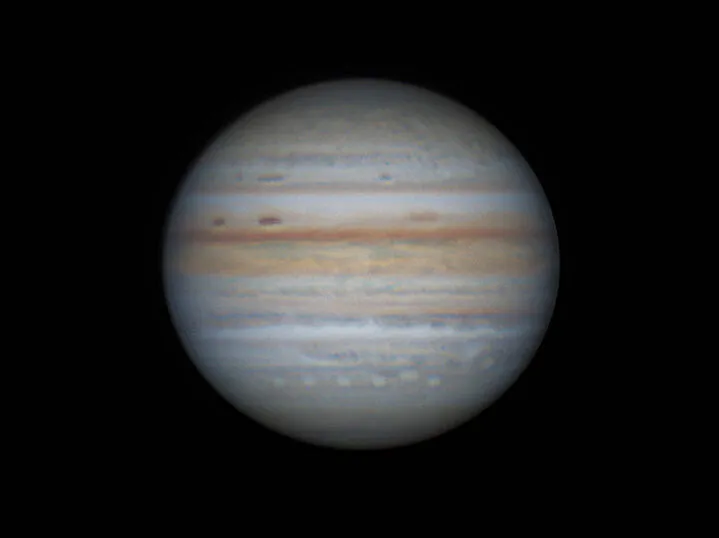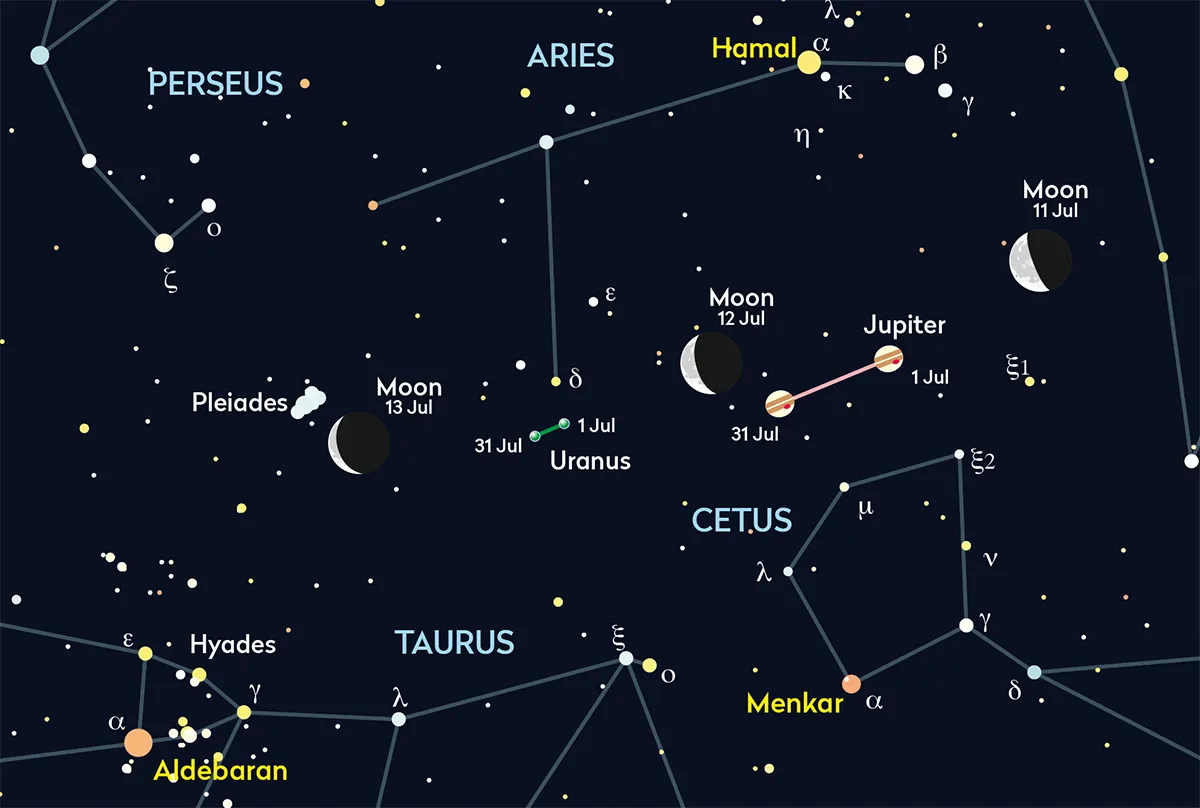Jupiter manages a decent altitude under dawn twilight by the end of July.
Currently a morning planet, mag. –2.1 Jupiter appears 2.9° from a 29%-lit waning crescent Moon on the morning of 12 July, rising above the east-northeast horizon around 01:20 BST (00:20 UT).
The planet has moved east from Pisces where it was last year and now sits in southern Aries.
Get regular stargazing advice by signing up to receive the BBC Sky at Night Magazine e-newsletter and listening to our weekly Star Diary podcast.

This is excellent news for the months ahead because as we approach opposition on 2 November 2023, Jupiter will be high in UK skies and visible in dark skies that last for a significant time.
Although the skies certainly can’t be described that way at present, it’s a price worth paying for the spectacle to come.
During July, Jupiter’s position slowly improves. On 1 July it rises just before 02:00 BST (01:00 UT) above the east-northeast horizon, a beacon shining at mag. –2.1.
By the time the sky starts to brighten before sunrise, Jupiter is around 20° altitude above the east horizon.

By the end of July, Jupiter rises at midnight BST (23:00 UT) and reaches an altitude of around 40° above the southeast horizon under brightening twilight.
Consequently, this is an excellent time to start observing and recording the planet.
By 31 July, Jupiter will have brightened very slightly to shine at mag. –2.2.
From the UK we can look forward to Jupiter reaching an altitude of around 50° under dark sky conditions in the weeks that follow – an exciting prospect, as it will raise the planet above the turbulent atmosphere that can otherwise blur fine detail in its atmosphere.
How to see the planets, July 2023

Jupiter
- Best time to see: 31 July
- Altitude: 30°
- Location: Aries
- Direction: East-southeast
- Features: Complex atmosphere, Galilean moons
- Recommended equipment: 75mm or larger
Mercury
- Best time to see: 15 June, 30 minutes after sunset
- Altitude: 2° (very low)
- Location: Cancer
- Direction: West-northwest
Mercury reaches superior conjunction on 1 July, thereafter slowly emerging into the evening sky. It’s best mid-month. On 10 July, mag. –1.0 Mercury sets 50 minutes after sunset.
By 25 July, Mercury dims to mag. –0.1, setting one hour after sunset. At July’s end, Mercury is near Venus. On 28 July, mag. +0.1 Mercury is 14 arcminutes from the mag. +1.3 star Regulus (Alpha (α) Leonis).
Venus
- Best time to see: 1 July, 30 minutes after sunset
- Altitude: 5° (low)
- Location: Leo
- Direction: West
Venus is currently approaching Earth, an evening planet with a poor position after sunset. Mag. –4.3 Venus sets less than 2 hours after sunset on 1 July, but by 31 July the offset is just a minute or two!
On 19 July, mag. –4.3 Venus is joined by mag. –0.3 Mercury, 13.2° to the right (northwest) and a slender 3%-lit waxing crescent Moon 4.3° above left (east-northeast) of Mercury.
Venus is a 33-arcsecond, 31%-lit waning crescent on 1 July. By 31 July its phase reduces to 5% and it appears 53 arcseconds across, its beautifully thin crescent best observed in daytime.
Mars
- Best time to see: 1 July, 1 hour after sunset
- Altitude: 9° (low)
- Location: Leo
- Direction: West
Mars hangs on in the evening twilight but is hard to see due to low altitude. On 1 July, shining at mag. +1.7, it’s near mag. –4.3 Venus.
On the evening of 9 July, Mars is 0.8° from mag. +1.3 Regulus, tricky to see under bright twilight. From the UK, an 8%-lit waxing crescent Moon sits right of Mars on 20 July.
Saturn
- Best time to see: 31 July
- Altitude: 26°
- Location: Aquarius
- Direction: South
Saturn is improving dramatically. Visible in the morning on 1 July, mag. +0.6 Saturn manages an altitude of 17° above the southeast horizon under dark twilight.
By the end of the month, Saturn reaches its highest altitude of 25°, due south under darkness. A bright 81%-lit waning gibbous Moon sits 3.8° south of Saturn on 7 July, best around 03:00 BST (02:00 UT).
Uranus
- Best time to see: 31 July, 02:30 BST (01:30 UT)
- Altitude: 19°
- Location: Aries
- Direction: East
Too close to the Sun at the start of July. By the end of July Uranus reaches 18° altitude under darkness, shining at mag. +5.8, 9.2° east-northeast of mag. –2.2 Jupiter and 8.7° southwest of the Pleiades.
Neptune
- Best time to see: 31 July, 02:30 BST (01:30 UT)
- Altitude: 29°
- Location: Pisces
- Direction: Southeast
Neptune is a morning planet in Pisces, southeast of the Circlet asterism. It’s best at the end of the month when it manages 29° above the southeast horizon under darkness.
This guide originally appeared in the July 2023 issue of BBC Sky at Night Magazine.
